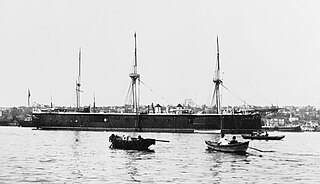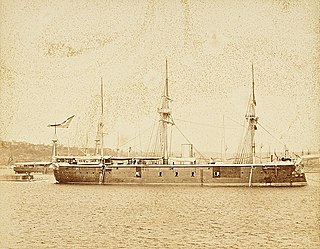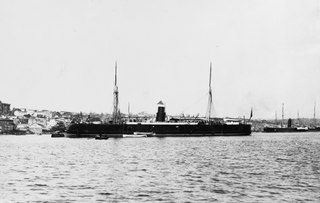
Mesudiye was a central-battery ironclad of the Ottoman Navy, one of the largest ships of that type ever built. She was built at the Thames Iron Works in Britain between 1871 and 1875. Mesudiye had one sister ship, though she was purchased by the Royal Navy and commissioned as HMS Superb. Her primary armament consisted of twelve 10-inch (250 mm) guns in a central armored battery.

Feth-i Bülend was an Ottoman ironclad warship built in the late 1860s, the lead ship of her class. The Ottoman Navy ordered her from the British Thames Iron Works, and she was laid down in 1868, launched in 1869, and commissioned in 1870. She was armed with four 229 mm (9 in) guns, was powered by a single-screw compound steam engine with a top speed of 13 knots.

Asar-i Tevfik was an ironclad warship of the Ottoman Navy built in the 1860s, the only member of her class. She was built as part of a major expansion program for the Ottoman fleet in the 1860s following the Crimean War. Asar-i Tevfik was a 4,600-metric-ton barbette ship armed with a main battery of eight 220-millimeter (8.7 in) guns in a central battery. In 1903–1906, the ship was extensively rebuilt in Germany and a new battery of 150 mm (5.9 in) and 120 mm (4.7 in) quick-firing guns replaced the older weapons.

Hamidiye was a unique ironclad warship built for the Ottoman Navy in the 1870s, the last vessel of the type completed for the Ottomans. She was a central battery ship, mounting most of her armament in a central casemate. The ship, built by the Ottoman Imperial Arsenal took nearly twenty years to complete; she was laid down in December 1874, launched in 1885, and completed in 1894. Due to her lengthy construction period, she was already obsolete by the time she was launched. Her poor handling and low quality armor contributed to a short career, spent almost entirely as a stationary training ship. She was briefly activated in 1897 during the Greco-Turkish War, but she was already in bad condition just three years after she entered service, as was the rest of the ancient Ottoman fleet. The Ottomans embarked on a reconstruction program after the incident humiliated the government, but Hamidiye was in too poor a state by 1903 to warrant rebuilding, and she was accordingly decommissioned that year, placed for sale in 1909, and sold to ship breakers in 1913.

Mukaddeme-i Hayir was the second of two Feth-i Bülend-class ironclads built for the Ottoman Navy in the 1860s. The Ottoman Navy ordered her from the Imperial Arsenal in Constantinople, and she was laid down in 1870, launched in 1872, and commissioned in 1874. She was armed with four 229 mm (9 in) guns, was powered by a single-screw compound steam engine with a top speed of 12 knots. The ship saw action during the Russo-Turkish War of 1877–1878, but was laid up from 1878 to 1897. At the start of the Greco-Turkish War in 1897, the Ottoman Navy mobilized Mukaddeme-I Hayir and the rest of the ironclad fleet but found almost all of the ships to be in unusable condition. Mukaddeme-i Hayir was disarmed the following year and converted into a stationary training ship in 1911. After the outbreak of World War I in 1914, she became a barracks ship, and served in this capacity until 1923, when she was broken up.

Avnillah was an ironclad warship built for the Ottoman Navy in the late 1860s. The lead ship of the Avnillah class, she was built by the Thames Iron Works in Britain. The ship was laid down in 1868, launched in 1869, and she was commissioned into the fleet the following year. A central battery ship, she was armed with a battery of four 228 mm (9 in) guns in a central casemate, and was capable of a top speed of 12 knots.

Muin-i Zafer was the second of two Avnillah-class casemate ships built for the Ottoman Navy in the late 1860s. The ship was laid down in 1868, launched in 1869, and she was commissioned into the fleet the following year. A central battery ship, she was armed with a battery of four 228 mm (9 in) guns in a central casemate, and was capable of a top speed of 12 knots.

The Avnillah class was a group of two ironclad warships built for the Ottoman Navy in the 1860s. The class comprised two vessels, Avnillah and Muin-i Zafer. The two ships were built in Britain between 1868 and 1870. They were armed with a battery of four 228 mm (9 in) guns mounted in a central casemate, making them central battery ships.

Lütf-ü Celil was an ironclad warship of the Ottoman Navy, the lead ship of the Lütf-ü Celil class. Originally ordered by the Khedivate of Egypt, an autonomous vassal state of the Ottoman Empire, the central Ottoman government forced Egypt to surrender Lütf-ü Celil while she was still under construction at the French Forges et Chantiers de la Gironde shipyard. Lütf-ü Celil saw action during the Russo-Turkish War in 1877, where she operated on the Danube to try to prevent Russian forces from crossing the river. While on patrol on 11 May, she engaged a Russian artillery battery that scored a hit on the ship's boiler room, causing an explosion that destroyed the ship and killed most of her crew.

Hifz-ur Rahman was the second of two Lütf-ü Celil-class ironclads built for the Ottoman Navy in the late 1860s. Originally ordered by the Khedivate of Egypt, an autonomous vassal state of the Ottoman Empire, the central Ottoman government forced Egypt to surrender Hifz-ur Rahman while she was still under construction at the French Forges et Chantiers de la Gironde shipyard. The vessel was a turret ship, armed with two 229 mm (9 in) Armstrong guns and two 178 mm (7 in) Armstrong guns, both pairs in revolving gun turrets.

The Lütf-ü Celil class was a pair of ironclad warships built for the Ottoman Navy by a French shipyard in the late 1860s. Originally ordered by the Eyalet of Egypt but confiscated by the Ottoman Empire while under construction, the class comprised the vessels Lütf-ü Celil and Hifz-ur Rahman. The ships were sea-going monitors that mounted their main battery of two 225 mm (8.9 in) Armstrong guns and two 178 mm (7 in) Armstrong guns in two revolving gun turrets.

Asar-i Şevket was a central battery ship built for the Ottoman Navy in the 1860s. Originally ordered by the Eyalet of Egypt but confiscated by the Ottoman Empire while under construction, the vessel was initially named Kahira. The ship was laid down at the French Forges et Chantiers de la Gironde shipyard in 1867, was launched in 1868, and was commissioned into the Ottoman fleet in March 1870. Asar-i Şevket was armed with a battery of four 178 mm (7 in) Armstrong guns in a central casemate and one 229 mm (9 in) Armstrong gun in a revolving barbette.

The Asar-i Şevket class of ironclad warships consisted of two vessels, Asar-i Şevket and Necm-i Şevket, built for the Ottoman Navy in the 1860s. The ships were constructed in France and were based on the design of the earlier ironclad Asar-i Tevfik. The two vessels, built as central battery ships, carried an armament of four 178 mm (7 in) Armstrong guns in a central casemate and one 229 mm (9 in) Armstrong gun in a revolving barbette atop the casemate.

Iclaliye ("Glorious") was a unique ironclad warship built for the Ottoman Navy in the late 1860s and early 1870s. She was ordered from the Austro-Hungarian shipyard Stabilimento Tecnico Triestino, was laid down in May 1868, and was completed in February 1871. The design for Iclaliye was based on the earlier Asar-i Şevket-class ironclads built in France, though she carried a slightly more powerful armament consisting of two 228 mm (9 in) Armstrong guns and three 178 mm (7 in) Armstrong guns. During the Russo-Turkish War she supported Ottoman forces fighting in the Caucasus. She spent most of the rest her career out of service, as the Ottoman Navy was allowed to languish. In 1912, the Navy activated the ancient Iclaliye to help provide artillery support to the forces defending Constantinople. She served in subsidiary roles, including as a training ship and a barracks ship, until 1928 when she was decommissioned and broken up.

Osmaniye, named for Sultan Osman I, was the lead ship of the Osmaniye class of ironclad warships built for the Ottoman Navy in the 1860s by Robert Napier and Sons of the United Kingdom. A broadside ironclad, Osmaniye carried a battery of fourteen 203 mm (8 in) RML Armstrong guns and ten 36-pounder Armstrongs in a traditional broadside arrangement, with a single 229 mm (9 in) RML as a chase gun. Among the more powerful of Ottoman ironclads, the Navy decided to keep the ship out of the action during the Russo-Turkish War of 1877–1878 to preserve the vessel. She spent the 1880s out of service, though she was heavily rebuilt in the early 1890s and converted into a more modern barbette ship. She was nevertheless in poor condition by the time of the Greco-Turkish War in 1897, as a result saw no action, and was disarmed after the war. She remained in commission until 1909 but saw no further service, and was broken up in 1923.

Aziziye, named for Sultan Abdülaziz, was the second of four Osmaniye-class ironclad warships built for the Ottoman Navy in the 1860s. The ship was laid down at the Robert Napier and Sons shipyard in 1863, was launched in January 1865 and was commissioned in August that year. A broadside ironclad, Aziziye carried a battery of fourteen 203 mm (8 in) RML Armstrong guns and ten 36-pounder Armstrongs in a traditional broadside arrangement, with a single 229 mm (9 in) RML as a chase gun. Among the more powerful of Ottoman ironclads, the Navy decided to keep the ship safely in the Mediterranean Sea during the Russo-Turkish War of 1877–1878 to preserve the vessel. She spent the 1880s out of service, though she was heavily rebuilt in the early 1890s and converted into a more modern barbette ship. She was nevertheless in poor condition by the time of the Greco-Turkish War in 1897, as a result saw no action, and was disarmed after the war. She saw no further active service, being used briefly as a barracks ship from 1904 to 1909. In 1923, she was sold to ship breakers and dismantled.

Orhaniye was an ironclad warship built for the Ottoman Navy by Robert Napier and Sons of the United Kingdom in the 1860s, the third of four members of the Osmaniye class. The ship's keel was laid down in 1863 and she was launched in June 1865. A broadside ironclad, Orhaniye carried a battery of fourteen 203 mm (8 in) RML Armstrong guns and ten 36-pounder Armstrongs in a traditional broadside arrangement, with a single 229 mm (9 in) RML as a chase gun. Among the more powerful of Ottoman ironclads, the Navy decided to keep the ship safely in the Mediterranean Sea during the Russo-Turkish War of 1877–1878 to preserve the vessel. She spent the 1880s out of service, though she was heavily rebuilt in the early 1890s and converted into a more modern barbette ship. She was nevertheless in poor condition by the time of the Greco-Turkish War in 1897, as a result saw no action, and was disarmed after the war. She was used as a barracks ship following her decommissioning in 1909, though this duty lasted only until 1913, when she was sold for scrap.

Mahmudiye, named for Sultan Mahmud II, was the fourth of four Osmaniye-class ironclad warships built for the Ottoman Navy in the 1860s. She was the only member of her class built at the Thames Iron Works, with work lasting from her keel laying in 1863 and her launching in 1864. A broadside ironclad, Mahmudiye carried a battery of fourteen 203 mm (8 in) RML Armstrong guns and ten 36-pounder Armstrongs in a traditional broadside arrangement, with a single 229 mm (9 in) RML as a chase gun. Among the more powerful of Ottoman ironclads, the Navy decided to keep the ship safely in the Mediterranean Sea during the Russo-Turkish War of 1877–1878 to preserve the vessel. She spent the 1880s out of service, though she was heavily rebuilt in the early 1890s and converted into a more modern barbette ship. She was nevertheless in poor condition by the time of the Greco-Turkish War in 1897, as a result saw no action, and was disarmed after the war. She saw no further active service, being used briefly as a barracks ship from 1909 to 1913, when she was sold to ship breakers and dismantled.

















